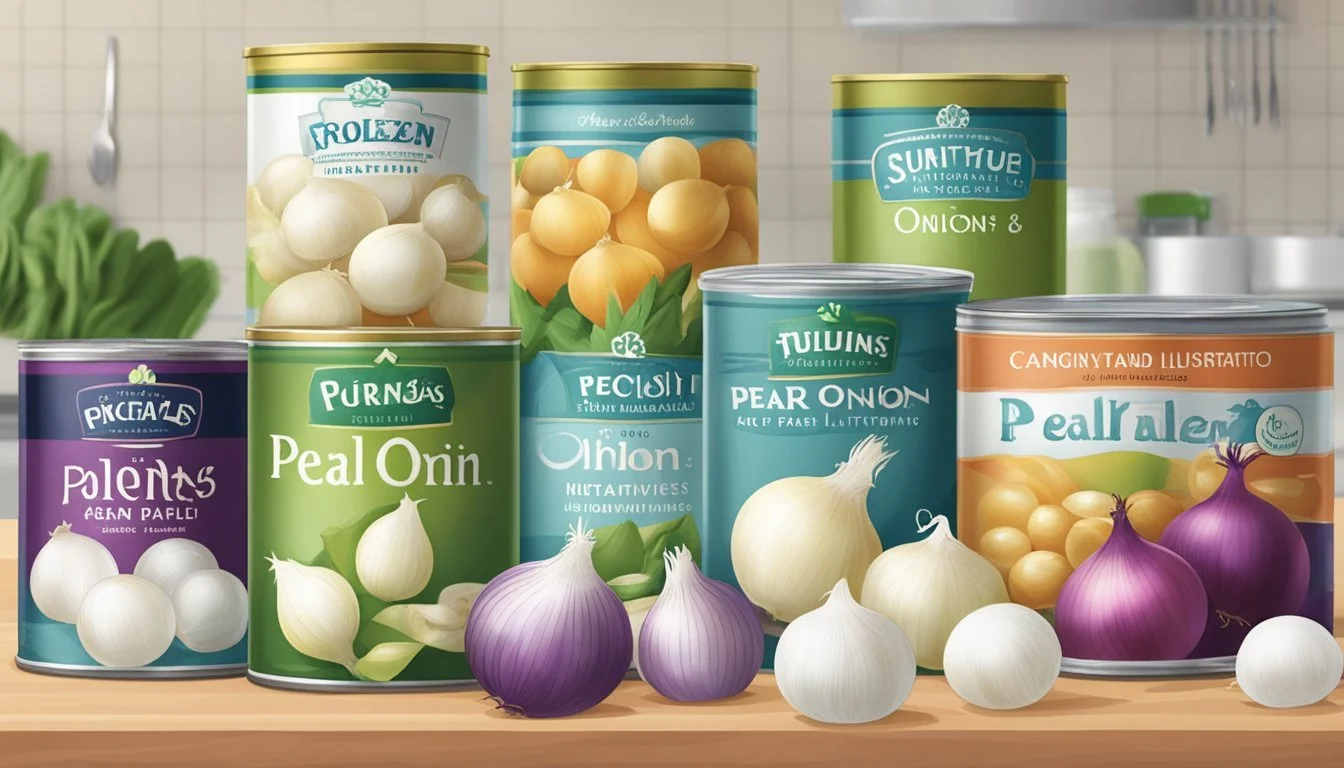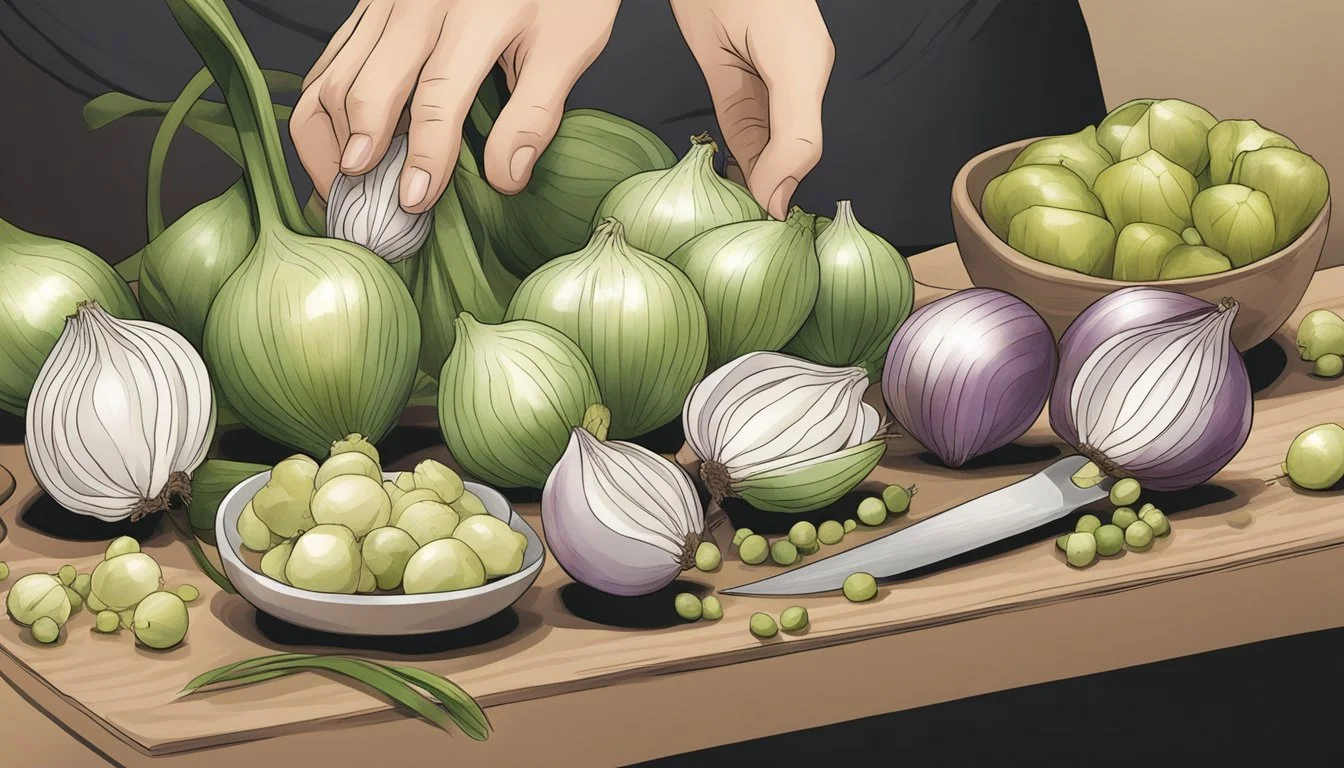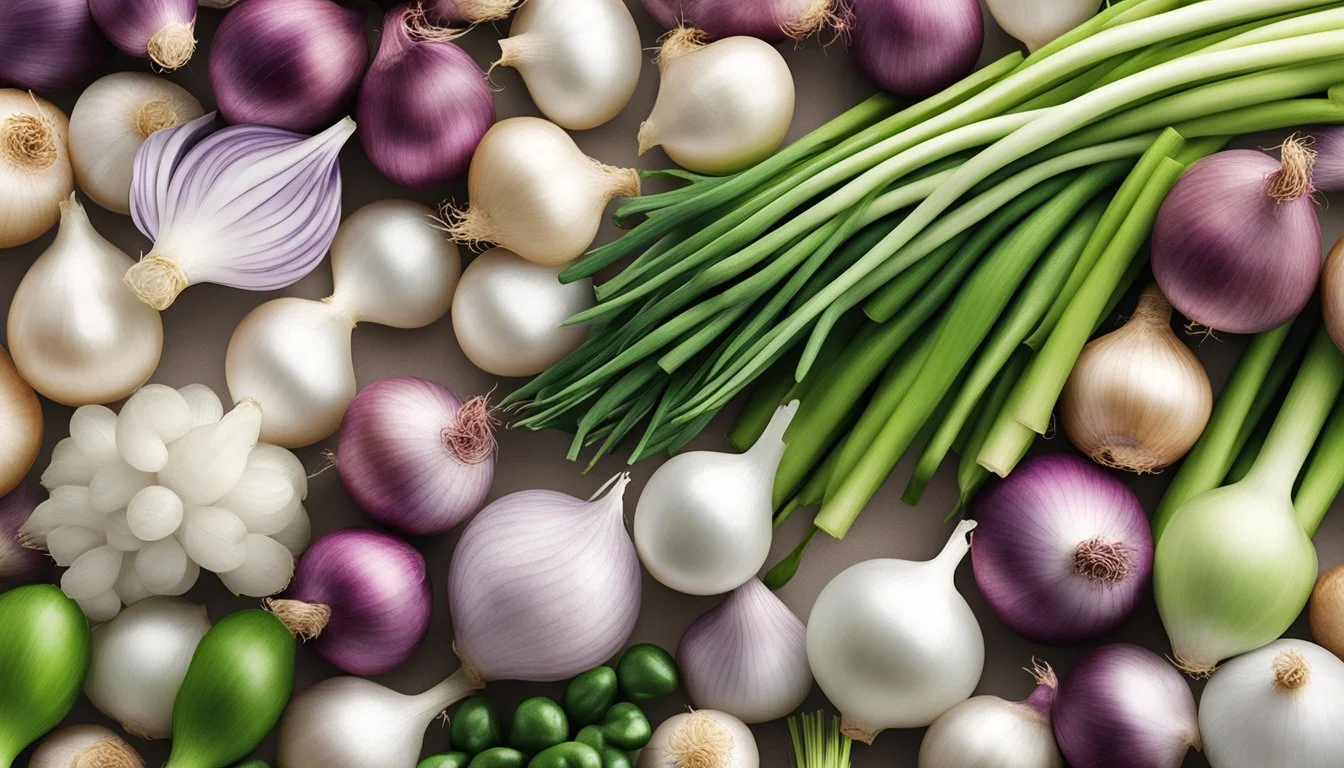Pearl Onions Substitutes
Top Alternatives for Cooking
Finding the perfect substitute for pearl onions can elevate your culinary creations without compromising on taste or texture. Frozen pearl onions are a top alternative, as they retain the sweet, slightly caramelized flavor that fresh pearl onions contribute to dishes. Additionally, they come pre-peeled, making them a convenient option for busy cooks.
For those looking to experiment with new flavors, the fennel bulb offers a unique, sweeter onion-like taste with a delicate licorice note. This can add a layer of complexity and brightness to your recipes. Leeks also present a viable substitute, offering an earthy, mildly sweet flavor that closely mirrors pearl onions when used in a variety of dishes.
Other substitutes such as shallots, cippolini onions, and even small white onions can also provide similar flavor profiles while adding their own unique twist to the meal. By exploring these alternatives, you can achieve the desired taste and texture in your cooking, ensuring every dish remains flavorful and satisfying.
Understanding Pearl Onions
Pearl onions are known for their distinct characteristics and versatility in culinary applications. This section will explore their unique flavor profile and common uses.
Characteristics of Pearl Onions
Pearl onions are small, round, and typically white, though they can also be red or gold. Their size ranges from 25 to 35 millimeters in diameter.
The flavor profile of pearl onions is mild and sweet, making them less pungent than regular onions. This mild sweetness makes them a versatile ingredient in various dishes.
Texture: Pearl onions are juicy and firm. When cooked, they become tender but hold their shape well.
Preparation: They often require peeling, which can be done easily by blanching. Blanching involves boiling them briefly and then plunging them into ice water to remove the skins.
Culinary Uses of Pearl Onions
Pearl onions shine in many cooking methods due to their size and flavor. Their subtle sweetness enhances both complex and simple dishes.
Soups and Stews: Pearl onions are excellent in soups and stews, where they provide a delicate onion flavor without overpowering other ingredients. They absorb the flavors of the broth while maintaining their texture.
Roasting: Roasted pearl onions develop a caramelized exterior and a soft, creamy interior. This method brings out their natural sweetness and juiciness.
Pickling: Pickling pearl onions preserves them and adds a tangy flavor that complements their inherent sweetness. Pickled pearl onions are great as condiments or garnishes.
Braises and Caramelized Dishes: In braises, pearl onions add depth to the dish. Caramelized pearl onions can serve as a flavorful topping for meats or in vegetable medleys.
Common Pearl Onion Substitutes
Several vegetables can replace pearl onions in recipes, offering a variety of flavors and textures that make them ideal substitutes.
Using Shallots as Alternatives
Shallots are an excellent substitute for pearl onions. They possess a milder flavor compared to regular onions, making them suitable for dishes that require a subtle yet complex onion taste.
Shallots have a slight garlic undertone, which enhances the overall flavor of many recipes. When using shallots as a substitute for pearl onions, the ratio is typically 1:1, although this can be adjusted based on taste preferences.
To use shallots, dice them finely to match the texture of pearl onions. This substitution works well in sauces, soups, and stews where a similar flavor profile is desired.
Regular Onions and Their Varieties
White, brown, and red onions are commonly used as substitutes for pearl onions due to their wide availability and versatility.
White onions have a sharper, more pungent flavor, making them suitable for bold dishes.
Brown onions offer a slightly sweet and robust flavor, which deepens when cooked, perfect for casseroles and roasts.
Red onions provide a milder taste and a vibrant color, ideal for salads and grilled dishes. To substitute for pearl onions, dice or slice these onions into smaller pieces to better mimic the size and texture of the original ingredient.
Leveraging Cipollini and Boiling Onions
Cipollini onions are small, flat, and sweet, making them a good match as a pearl onion substitute. They caramelize well due to their high sugar content, contributing a rich and sweet flavor to dishes.
Boiling onions, slightly larger than pearl onions, are also a viable substitute. They are especially good in recipes requiring whole onions, such as stews and braises. Their mild flavor allows them to blend seamlessly into a variety of dishes.
When using cipollini or boiling onions in place of pearl onions, the cooking time may need adjustment due to their size. Both options offer a similar flavor profile and can enhance many dishes.
In summary, the choice of substitute depends on the dish’s flavor requirements and the desired texture.
Alternative Alliums for Substitution
Several alliums serve as excellent substitutes for pearl onions. These alternatives offer unique flavor profiles and textures, making them versatile additions to various dishes.
Utilizing Leeks and Scallions
Leeks have a mild, sweet flavor. They are a close relative of the pearl onion and share a similar taste. Leeks can be used in soups, stews, and casseroles. When substituting leeks for pearl onions, use the white and light green parts.
Scallions are another suitable substitute with a stronger bite than leeks but still a mild onion flavor. Use them raw in salads or cooked in various dishes. Both leeks and scallions provide depth of flavor without overpowering other ingredients.
Green Onions or Scallions
Green onions, also called scallions, have a more intense flavor than pearl onions but are still milder than regular onions. Use them in recipes requiring a slight onion flavor without overwhelming other tastes.
The green tops add color and freshness to dishes. When using green onions as a substitute, both the white base and green stalks should be utilized. This versatility makes green onions a valuable option in many recipes.
The Role of Garlic and Chives
Garlic, though not an onion, adds a robust, aromatic flavor. Use it sparingly to avoid overpowering the dish. Garlic can replace pearl onions in savory recipes, particularly when a strong flavor is desired.
Chives offer a subtle onion flavor and are best used raw or added at the end of cooking. They can be sprinkled on soups, salads, and garnished dishes. Their delicate taste and vibrant green color make them an excellent, mild substitute for pearl onions.
Non-Allium Substitutes
For those seeking alternatives to pearl onions that do not belong to the allium family, consider options like fennel bulbs, celery, carrots, and caperberries. These substitutes offer unique flavors and textures that can complement various dishes effectively.
Fennel Bulb for a Unique Twist
The fennel bulb, with its sweet and delicate flavor, provides a distinctive alternative to pearl onions.
Its licorice-like taste differs from the more pungent allium flavors, making it suitable for dishes where a subtle sweetness is desired. Fennel bulbs add an aromatic complexity to stews, roasts, and salads.
In addition to flavor, their unique texture holds up well in cooking, offering a pleasant combination of crunch and tenderness. Use fennel bulbs in similar quantities to pearl onions, adjusting to taste.
Using Celery and Carrots for Texture
Celery and carrots can be excellent substitutes for pearl onions, particularly when texture is a key component.
Celery brings a crisp, crunchy texture and a slightly bitter taste that can balance richer flavors in soups and casseroles. Carrots add sweetness and a vibrant color, making them visually appealing in various dishes.
Both vegetables are versatile and blend well with many ingredients, providing a hearty and satisfying bite without the onion flavor. It's recommended to chop them into small, bite-sized pieces to mimic the size and texture of pearl onions.
Other Substitutes: Caperberries and More
Caperberries, though not as common, are an intriguing alternative to pearl onions.
They offer a briny, tangy flavor that can enhance salads, sauces, and garnishes, providing a unique twist to recipes. The distinct taste of caperberries pairs well with Mediterranean and seafood dishes, adding a burst of flavor that stands out.
Aside from caperberries, other substitutes such as artichoke hearts or small pickled vegetables can also be considered depending on the dish’s requirements and desired flavor profiles. These alternatives bring both culinary interest and variety to meals, expanding the palette beyond traditional onion flavors.
Frozen and Canned Pearl Onion Alternatives
Frozen and canned pearl onions offer convenient and practical substitutes for fresh pearl onions. Each has distinct characteristics, benefits, and potential drawbacks, making them suitable for various culinary applications.
Pros and Cons of Frozen Pearl Onions
Pros:
Convenience: Frozen pearl onions save time, as they don't require peeling.
Availability: They are typically available year-round.
Nutrient Retention: Contrary to common beliefs, freezing can retain most nutrients.
Consistency: They maintain a consistent quality and texture.
Cons:
Texture: The freezing process can sometimes leave them with a softer texture compared to fresh onions.
Flavor: While close to fresh, frozen onions may have a slightly less robust taste.
Storage: They require freezer space and proper storage to avoid freezer burn.
When to Use Canned Pearl Onions
Pros:
Shelf Life: Canned pearl onions have a longer shelf life compared to fresh or frozen alternatives.
Convenience: They come ready to use, requiring no additional preparation or defrosting.
Availability: Easily accessible in most grocery stores.
Cons:
Sodium Content: Often, canned vegetables contain added sodium, which may not be suitable for all diets.
Texture: Canned onions can be softer and possibly mushy, making them less ideal for dishes needing a firmer bite.
Flavor: There can be a slight metallic or preserved taste from the canning process.
Usage:
Cooking Methods: Ideal for slow-cooked dishes, stews, and casseroles where the texture and flavor integrate well.
Preparation: Can be used directly from the can, just remember to drain and possibly rinse to reduce sodium content.
Preparation and Cooking Tips
Effective preparation and cooking techniques can elevate the flavor and texture of pearl onions or any of their substitutes. The methods discussed below ensure that whether using regular onions, shallots, or other alternatives, the dish retains its desired taste and appeal.
Peeling and Blanching Techniques
Peeling pearl onions can be tedious without the right technique. Blanching makes this task easier. First, trim both ends of the onion. Boil water in a pot and add the onions for about 2 minutes. Transfer them immediately to an ice water bath using a slotted spoon.
This process loosens the skin, allowing it to slip off effortlessly. For substitutes like shallots or cipollini onions, this blanching method works just as well. For larger onions, peeling can be simplified by cutting them into halves or quarters before applying the same technique.
Sautéing and Caramelizing for Maximum Flavor
Sautéing and caramelizing are key methods to develop deep, rich flavors in pearl onions and their substitutes. Begin with heating oil or butter in a pan over medium heat. Add the onions, ensuring they are in a single layer for even cooking.
Stir occasionally until they turn translucent. To caramelize, continue cooking until they achieve a deep golden-brown color, which may take 20-30 minutes. This method enhances the sweetness and complexity, particularly in substitutes like fennel bulbs and regular onions. Adjust the heat to prevent burning, and add a splash of broth or water if they stick to the pan.
Adjusting Cooking Times for Substitutes
Cooking times vary depending on the substitute used. Pearl onions generally take about 20-30 minutes to cook through. Shallots and cipollini onions may require similar times but keep an eye on them to prevent overcooking due to their thin layers.
Larger onions, when used as substitutes, may need an extended time, especially if caramelizing. Regular onions, if diced, cook faster and become sweeter more quickly. Slicing or dicing these larger substitutes can help match the cooking time of pearl onions more closely. Adjust seasons and liquids as necessary to achieve a balanced and flavorful dish.
Nutritional and Health Considerations
Pearl onions, also known as baby onions or small onions, provide a range of nutrients beneficial for overall health.
Nutritional Profile:
Calories: Low calorie content
Vitamins: Rich in Vitamin C and Vitamin B6
Minerals: Good source of potassium and manganese
These nutrients support essential bodily functions, such as immune system health and energy metabolism.
Fiber Content: Pearl onions are an excellent source of dietary fiber. Fiber aids in digestion and helps maintain a healthy gastrointestinal tract.
Antioxidants: They contain antioxidants like quercetin, which helps neutralize free radicals in the body. This may reduce inflammation and decrease the risk of chronic diseases.
Glycemic Index: Pearl onions have a low glycemic index, making them suitable for managing blood sugar levels.
Health Benefits:
Heart Health: May lower the risk of heart disease through a combination of fiber, potassium, and antioxidants.
Bone Health: Vitamin K and certain minerals contribute to bone health and strength.
Weight Management: Low in calories and high in fiber, they help in achieving and maintaining a healthy weight.
These nutritional attributes underscore the importance of including pearl onions in a balanced diet.







